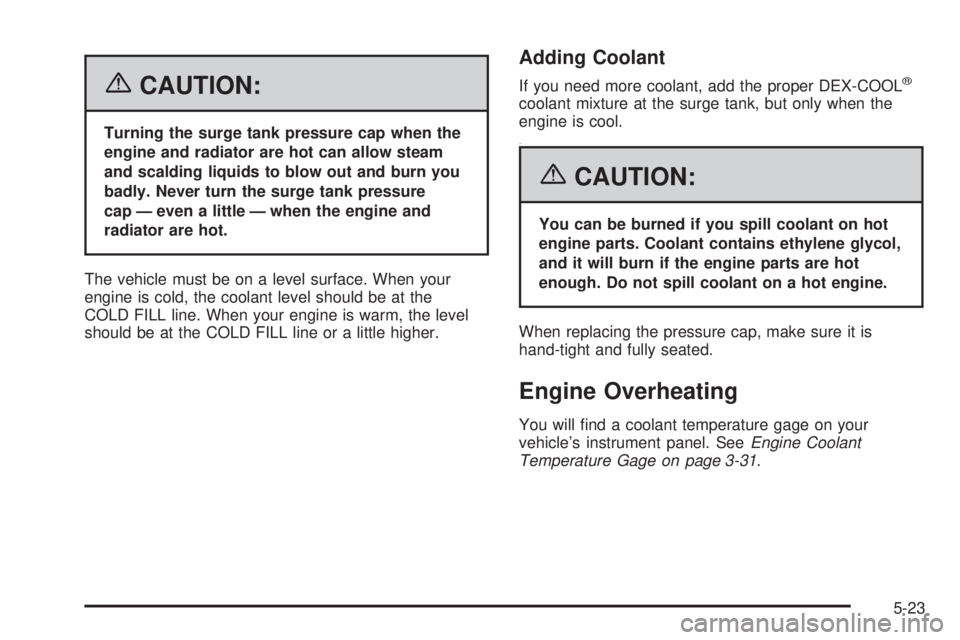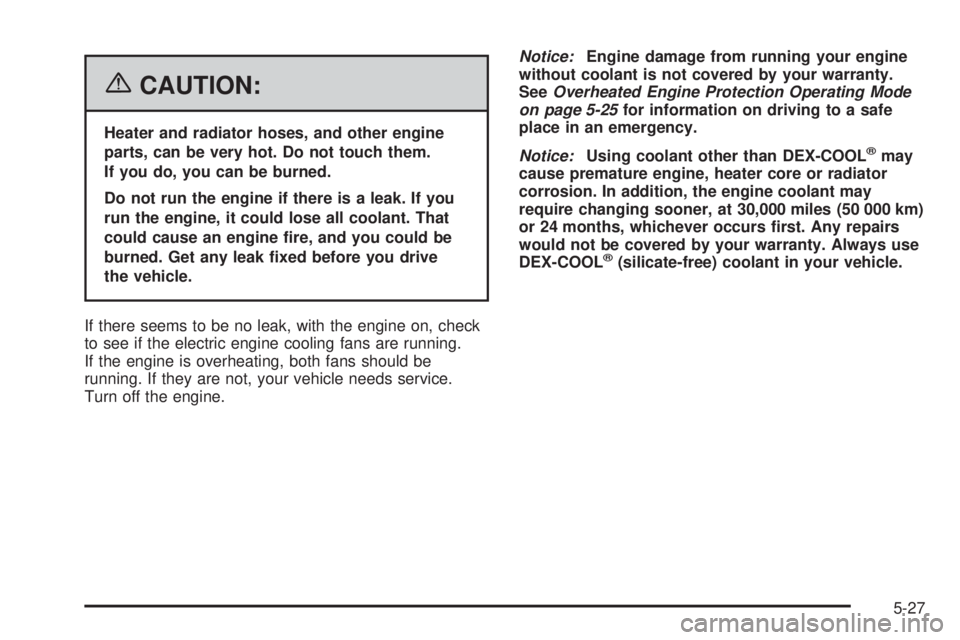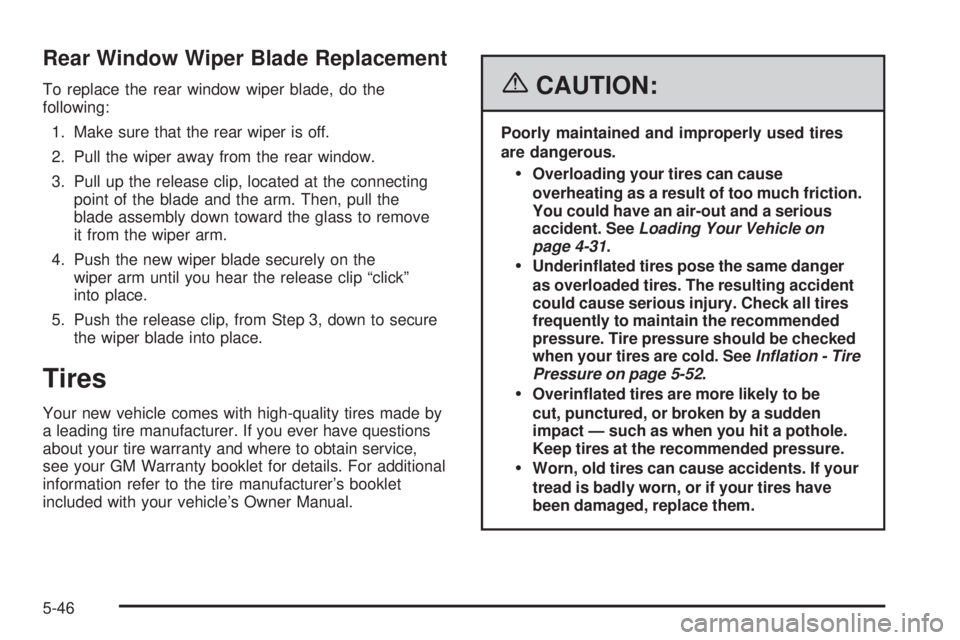Page 259 of 368

{CAUTION:
Turning the surge tank pressure cap when the
engine and radiator are hot can allow steam
and scalding liquids to blow out and burn you
badly. Never turn the surge tank pressure
cap — even a little — when the engine and
radiator are hot.
The vehicle must be on a level surface. When your
engine is cold, the coolant level should be at the
COLD FILL line. When your engine is warm, the level
should be at the COLD FILL line or a little higher.
Adding Coolant
If you need more coolant, add the proper DEX-COOL®
coolant mixture at the surge tank, but only when the
engine is cool.
a
{CAUTION:
You can be burned if you spill coolant on hot
engine parts. Coolant contains ethylene glycol,
and it will burn if the engine parts are hot
enough. Do not spill coolant on a hot engine.
When replacing the pressure cap, make sure it is
hand-tight and fully seated.
Engine Overheating
You will �nd a coolant temperature gage on your
vehicle’s instrument panel. SeeEngine Coolant
Temperature Gage on page 3-31.
5-23
Page 263 of 368

{CAUTION:
Heater and radiator hoses, and other engine
parts, can be very hot. Do not touch them.
If you do, you can be burned.
Do not run the engine if there is a leak. If you
run the engine, it could lose all coolant. That
could cause an engine �re, and you could be
burned. Get any leak �xed before you drive
the vehicle.
If there seems to be no leak, with the engine on, check
to see if the electric engine cooling fans are running.
If the engine is overheating, both fans should be
running. If they are not, your vehicle needs service.
Turn off the engine.Notice:Engine damage from running your engine
without coolant is not covered by your warranty.
SeeOverheated Engine Protection Operating Mode
on page 5-25for information on driving to a safe
place in an emergency.
Notice:Using coolant other than DEX-COOL®may
cause premature engine, heater core or radiator
corrosion. In addition, the engine coolant may
require changing sooner, at 30,000 miles (50 000 km)
or 24 months, whichever occurs �rst. Any repairs
would not be covered by your warranty. Always use
DEX-COOL
®(silicate-free) coolant in your vehicle.
5-27
Page 282 of 368

Rear Window Wiper Blade Replacement
To replace the rear window wiper blade, do the
following:
1. Make sure that the rear wiper is off.
2. Pull the wiper away from the rear window.
3. Pull up the release clip, located at the connecting
point of the blade and the arm. Then, pull the
blade assembly down toward the glass to remove
it from the wiper arm.
4. Push the new wiper blade securely on the
wiper arm until you hear the release clip “click”
into place.
5. Push the release clip, from Step 3, down to secure
the wiper blade into place.
Tires
Your new vehicle comes with high-quality tires made by
a leading tire manufacturer. If you ever have questions
about your tire warranty and where to obtain service,
see your GM Warranty booklet for details. For additional
information refer to the tire manufacturer’s booklet
included with your vehicle’s Owner Manual.
{CAUTION:
Poorly maintained and improperly used tires
are dangerous.
Overloading your tires can cause
overheating as a result of too much friction.
You could have an air-out and a serious
accident. SeeLoading Your Vehicle on
page 4-31.
Underin�ated tires pose the same danger
as overloaded tires. The resulting accident
could cause serious injury. Check all tires
frequently to maintain the recommended
pressure. Tire pressure should be checked
when your tires are cold. SeeInflation - Tire
Pressure on page 5-52.
Overin�ated tires are more likely to be
cut, punctured, or broken by a sudden
impact — such as when you hit a pothole.
Keep tires at the recommended pressure.
Worn, old tires can cause accidents. If your
tread is badly worn, or if your tires have
been damaged, replace them.
5-46
Page 360 of 368

D
Daytime Running Lamps..................................3-14
Daytime Running Lamps Indicator Light.............3-37
Defensive Driving............................................. 4-2
Delayed Locking............................................... 2-7
Doing Your Own Service Work........................... 5-4
Dome Lamp...................................................3-16
Door
Automatic Door Lock..................................... 2-8
Delayed Locking........................................... 2-7
Locks.......................................................... 2-6
Power Door Locks......................................... 2-7
Programmable Automatic Door Unlock.............. 2-8
Rear Door Security Locks............................... 2-8
Driver
Position, Safety Belt.....................................1-18
Seat Height Adjuster...................................... 1-3
Six-Way Power Seat...................................... 1-3
Driving
At Night.....................................................4-16
City...........................................................4-20
Defensive..................................................... 4-2
Drunken....................................................... 4-3
Freeway.....................................................4-21
Hill and Mountain Roads..............................4-24
In Rain and on Wet Roads...........................4-17
Rocking Your Vehicle to Get it Out.................4-31
Winter........................................................4-26
E
Electrical System
Add-On Equipment......................................5-83
Engine Compartment Fuse Block...................5-85
Fuses and Circuit Breakers...........................5-83
Instrument Panel Fuse Block.........................5-84
Power Windows and Other Power Options......5-83
Windshield Wiper Fuses...............................5-83
Engine
Air Cleaner/Filter.........................................5-18
Battery.......................................................5-34
Change Engine Oil Light...............................3-36
Check and Service Engine Soon Light............3-32
Coolant......................................................5-21
Coolant Heater............................................2-18
Coolant Temperature Gage...........................3-31
Coolant Temperature Warning Light................3-31
Engine Compartment Overview......................5-12
Exhaust.....................................................2-25
Oil .............................................................5-13
Oil Life System...........................................5-16
Overheated Protection Operating Mode...........5-25
Overheating................................................5-23
Reduced Power Light...................................3-36
Starting......................................................2-17
Entry Lighting.................................................3-17
Event Data Recorders (EDR)............................7-10
Extender, Safety Belt.......................................1-30
4